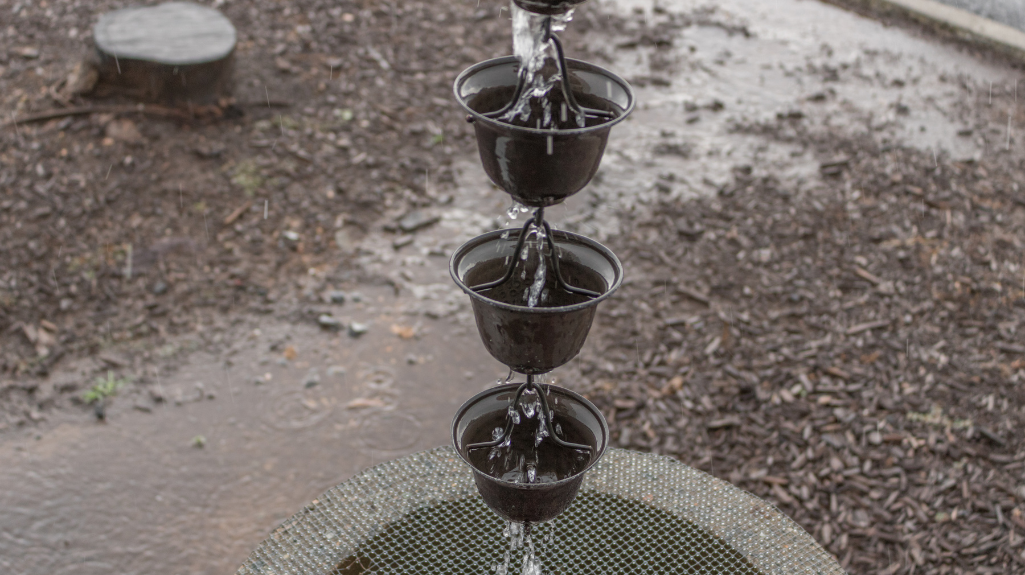SO WHAT IS A RAIN CHAIN ANYWAY?
Firstly, let us tell you what exactly a rain chain is. Rain chains were first used in commercial buildings and modern houses to get rid of the need for downpipes connected to roof gutters. Instead of the rainwater being channelled down a sometimes ugly-looking downpipe, the rain runs off the roof into a gutter and then runs down a chain to the ground. Here, it flows onto the ground into a stormwater drain or into the ground, garden bed, pond or water feature. We landscapers love the fact that something drab and boring, like a downpipe, can become a beautiful garden feature!
Lately, the DIY movement got a hold of the idea and took rain chains to a whole new level of cool and fun to make. Moreover, rain chains are beneficial because they actually slow the flow of the water down. The flowing water has to bump and trickle down the grooves of the chain links and objects. This then prevents soil erosion when it runs into the ground as the flow is slower. They also create a subtle amount of white noise, like a water feature. Furthermore, rain chains help to ionise the air around them, which is beneficial to us, animals and plants.
So, let’s have a look at some fun ideas to make your own rain chain for your home or garden. You can attach them to any roof you have or replace some of your downpipes with them. In addition, you can also attach them to a roof that needs more run-off.

What Tools will you require to make your own Rain Chain?
Make sure you have a tape measure, step ladder, gloves, socket wrench, drilling machine and drill bits, chain and links, pliers, hacksaw and metal cutters to remove down pipes and re-attach your new rain chain. Certainly, the most important “tool” you will need is your imagination. Just let those creative juices flow and try your own ideas!
What Materials can be used to make a Rain Chain?
Below is a list of some of the materials you can use to make a rain chain.
You can use the following for your rain chain: Copper chains and vessels, Aluminium, Upcycled metal objects, Plastic, Glass, and natural materials like sea shells, pebbles and rocks.
Now, let us discuss each of the above-mentioned materials in a little more detail.
COPPER CHAINS AND VESSELS. It’s a popular material for an awesome rain chain.
This is a popular one due to the beautiful oxidation that occurs when copper is exposed to the elements, giving it a green patina. Use wire links or chains to create a string of little copper ‘buckets’, vessels or ornaments that the water will trickle and flow through. Make sure the bottom of each vessel has a hole in it to allow the water to flow through. Moreover, you can plant up the containers with small plants like succulents that don’t mind periods of low water.
ALUMINIUM
Aluminium is a bright, silvery-white metal that gets a stony texture when it oxidizes and can look pretty interesting. In addition to its good looks, it is a very soft and light metal and quite easy to cut yourself into different shapes. Combine it with heavier chain links or objects to give the chain some weight for windy conditions.

UPCYCLED METAL OBJECTS
Get really creative and visit your local flea market to find interesting metal objects that you can use in your rain chain. Think old vintage spoons, even metal teapots, tin cups, old keys or large picture hooks.


PLASTIC and glass
Plastic is a very versatile material for rain chains. Unfortunately, it does have some drawbacks you need to be aware of. Sun ages plastic very quickly, and it will quickly become brittle and break if in a sunny spot. Furthermore, it also stretches quite easily when it becomes hot. Your chain should include some metal links to prevent stretching. But there are so many fun colours and plastic items you can upcycle for a rain chain, such as plastic bottles, which can be cut into all sorts of shapes like flowers or vessels.
Glass is a lovely material for a rain chain as the light catches it, and on a sunny day, it also looks so beautiful as a garden feature. Make sure you take extra safety precautions if you are cutting it yourself. Think about old wine bottlenecks, collected sea glass wrapped in wire, upcycled wine glasses and old pieces of mirror.


NATURAL MATERIALS works wonders for your DIY rain chain project
Different sea shells and pieces of driftwood, terracotta pots or old pieces of broken ceramic plates, mosaiced pieces, pebbles and rocks can all be used with wire to create beautiful rain chains that have a more natural and organic feeling.

Have a look at Pinterest to discover some amazing rain chain inspiration if you want to create your own. It can be a fun and relatively easy weekend project as long as you gather all your materials and tools before you start.
Happy gardening!
Source:
